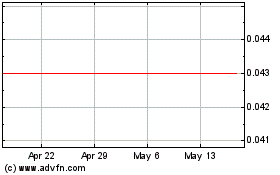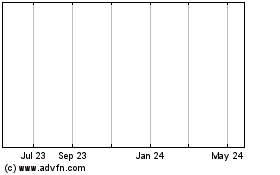Asian Shares Mixed as China Opens Weak--Update
January 15 2016 - 12:21AM
Dow Jones News
By Chao Deng
China shares slipped Friday, as worries about slowing growth in
the world's second-largest economy kept a lid on gains in Asia.
Throughout the region, stock benchmarks were down slightly, as
investors remained nervous following a sharp early-year
selloff.
The Shanghai Composite Index was down 1.5% at 2961.47 midday,
still hovering near its lows from last summer and near a bear
market, defined as a 20% or more drop from a recent high. The
benchmark was down 16% year-to-date.
The energy sector in Australia by midday had given up most of
its early gains as oil prices dipped. The S&P/ASX 200 was down
0.7%. The Hang Seng Index was down by 0.8% and South Korea's Kospi
was off 1.1%.
Japan's Nikkei Stock Average fell 0.4%.
While China's yuan, the initial trigger of much of the rout, has
stabilized for the time being, traders and analysts said investors
still worry about how China will intervene in its markets, after
authorities made several policy reversals last week.
"There's nothing really out there giving people encouragement,"
said Andrew Sullivan, managing director at Haitong International in
Hong Kong.
Overnight, some of the most beaten-down corners of the market,
from oil producers to miners and biotechnology stocks, carved out
sharp gains in the U.S. The Dow Jones Industrial Average rose 1.4%
and the S&P 500 rose 1.7%. U.S.-traded oil futures gained
overnight 2.4% to $31.20 a barrel.
But oil prices turned lower during the Asia day, with Brent
crude oil last down 0.91% at $30.61 a barrel.
"We haven't necessarily hit the bottom," said Mohit Bajaj,
managing director at brokerage WallachBeth Capital LLC. The energy
sector has lost 9% and 12% in Australia and Hong Kong respectively
year-to-date.
Early Friday, China's central bank set the yuan at 6.5637 to one
U.S. dollar, marking the sixth-straight session it has guided the
currency roughly steady.
In the freely traded offshore market, the yuan traded at 6.6162
to one U.S. dollar, up 0.3% from the previous day. Onshore, where
the yuan can trade up or down 2% from the central bank's daily fix,
the currency traded at 6.5866, roughly unchanged from the previous
day.
The Japanese yen was up 0.2% at Yen117.85 to one U.S. dollar.
The local currency has gained 2% year-to-date, as turmoil in
Chinese and global markets have sent investors to rush for
safety.
The Indonesian rupiah strengthened 0.1% to 13,895 to one U.S.
dollar. The currency had fallen as much as 1% on Thursday after
news of explosions in the Southeast Asian country's capital city of
Jakarta, although it recovered slightly after suspected government
intervention following a rate cut by the central bank.
The Hong Kong dollar, which is pegged to the U.S. dollar, traded
at 7.7846 to one U.S. dollar, after recording its sharpest drop in
more than a dozen years overnight to as weak as 7.7894.
Gold prices were up 0.4% to $1,078 a troy ounce.
Write to Chao Deng at Chao.Deng@wsj.com
(END) Dow Jones Newswires
January 15, 2016 00:06 ET (05:06 GMT)
Copyright (c) 2016 Dow Jones & Company, Inc.
Liquefied Natural Gas (ASX:LNG)
Historical Stock Chart
From Mar 2024 to Apr 2024

Liquefied Natural Gas (ASX:LNG)
Historical Stock Chart
From Apr 2023 to Apr 2024
